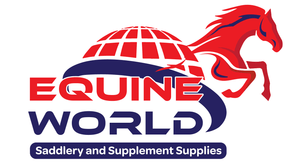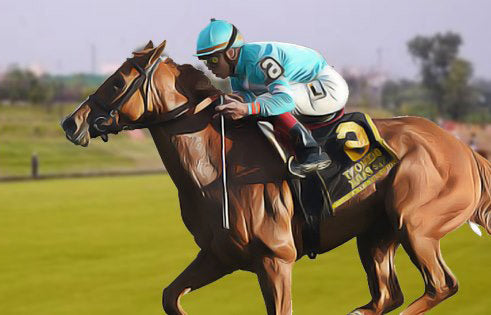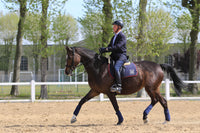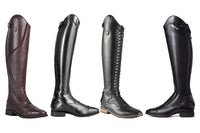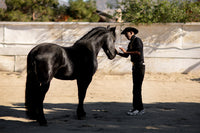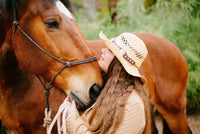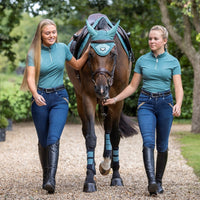Horseback riding is an enjoyable activity, and while it is leisure for some people, it is a sport for others. For a saddler, in addition to having a horse, you must have the best equipment for horse riding. A decent saddle, chaps, blanket, halter, Horse Bridle, riding boots, and rugs are essential. But it is the bridle that controls the horse's movements.
What is the horse bridle for?
A bridle is a mandatory equipment designed for horses, widely used in the training process. The choice of the bridle in the horse taming process is because it is a lighter opening, which generates smoother actions. Also, we can use it on veteran horses if the rider feels that the horse responds well to commands.
What is the difference between Horse bridle and flanges?
The horse bridle has different rings, which tie the bridle and butt. On the other hand, the flange has a single ring, into which the flange and the flange are fastened. The flanges should fit the corners of the lips as they act on them.
The brake, on the other hand, serves on the bars, a region devoid of teeth. The brake does not specify the training process. However, it allows for better responses from the horse. You can check our Equestrian Shop online for an exclusive Equestrian discount on bridles and parts.
Know the parts of a Horse Bridle:
The bridle refers to the set of straps placed on the head of the equine, adjusted both to its neck and its mouth, giving the possibility of controlling it either as a rider using reins or without being on the horse through a rope. There are different types of bridle and materials with which they are made. However, this component is crucial for the safety of the horse. It must be comfortably placed to avoid causing damage to the equine and the person who rides it both on horseback and foot because if you feel pain, discomfort, or the bridle slips, severe consequences could generate.
Let’s see the parts of a Horse Bridle:
- Bridle: It is a leather, hemp or silk garnish placed on the horse's head. It is divided into two bands, a so-called headpiece that will be located just behind the animal's ears on its head.
- Browband: The browband is the strap that goes across the forehead and prevents the headband from moving backward. The muffler must well adjust to avoid the headpiece from passing over the ears. The noseband prevents the horse from opening its mouth wide and crossing its jaw. It is located practically on the horse's forehead. It serves to strengthen the bite.
- Noseband: A strap that turns the horse's muzzle above the nose and serves to secure the bit's position.
- Throatlatch: Strap that is part of the bridle head. It is fastened under the horse's throat to prevent the bridle from slipping over the head.
- Rails: Also known as uprights, they serve to keep the bridle in the animal's mouth. One end of the rails is attached to the headboard and the other to the mouth.
- Mouthpieces: Object, usually made of metal or rubber, attached to the bridle and placed in the horse's mouth to gain control and directing.
- Reins: a pair of long and narrow straps attached to the mouthpiece on both sides of the equine's mouth and that goes on each side of the neck to the rider's hands, allowing him to direct and control the horse.
Equipment for horse riding: What equipment do you need to ride a horse?
Before practicing any equestrian discipline, the rider must select the necessary equipment for horse riding to feel comfortable and be protected against the possible risks that may arise.
Why buy equipment for horse riding
Throughout history, the horse club has evolved. Starting in the last third of the 20th century, when horses went from carrying out agricultural and military uses to being sportsmen and used in leisure, this is when their equipment takes a significant turn.
The outfit is a mix of tradition (leather) and modernity. For example, saddles are more anatomical for both the rider and the horse. Or we can also find new alloys and shapes for the mouthpieces.
Let’s talk about the essential equipment when riding a horse.
-
Rider's Clothing
The garments must be comfortable and facilitate movement in addition to protecting the wearer. Buying quality equestrian clothing is an investment for any rider as it allows you to enjoy more of the moments on horseback, knowing that you are protected.
The basic garments are helmet, vest or protective body, jacket, gloves, riding pants or breeches, chaps, and equestrian boots.
-
Helmet
In addition to being mandatory and being part of the essential equipment in any equestrian discipline, it is the fundamental element in the protection and safety of the rider. On the inside, comfortable and padded materials are used. They are usually made of unique materials composed of resin or plastic. These exterior materials absorb impacts and prevent the helmet from splitting and digging into the rider's head.
It is vital to ensure that the equestrian helmet purchased is homologated to ensure that the quality is good and provides us with security. Do not skip the Equestrian discount offer.
-
Protective vest or body
This vestment, like the helmet, is essential for the rider's safety during riding. It is mandatory for minors always and for adults in some equestrian disciplines. However, its use is recommended at any time as it absorbs shock to avoid possible injuries that may occur to the rider.
-
Saddle
We can find a great variety in the market, different according to the equestrian practices to be carried out: jumping, dressage, horseball, raid or general use. Saddlery & Tack must sit appropriately on the back of our horse and allow complete freedom of movement. The beams must rest along their entire length on the back so that the chair is well balanced. A poorly adjusted saddle can cause pain to our horse and will not allow the rider to ride well.
-
Jacket
It is perhaps one of the most characteristic garments of the riders' equipment. It is a garment chosen for its aesthetics that provides more than its protection. They are usually classic cut and cool colors.
-
Gloves
They are not mandatory, and, therefore, the decision of whether to use them or not rests with the rider. However, they are a decent complement to avoid the discomfort that the reins can cause in the hands and prevent scratches in the event of a fall.
If you decide to use them, it is best to choose a tight-fitting glove that adapts to the shape of your hands and is comfortable. They must not reduce the movements of the rider's hands while he handles the reins of his horse.
-
Riding Pants or Breeches
The pants specially designed for horse riding are made of elastic and resistant fabrics that prevent wear and tear with continuous friction with the horse. Pants should fit the body of the rider but without reducing movement. The choice of a comfortable garment that allows ease in any type of movement should prevail
-
Chaps
As with the pants, all the equipment for the legs is in constant contact with our horse's body. It is therefore essential to choose long chaps with padded protection to avoid chafing. Buy online at the Equestrian Shop.
-
Protectors and bandages
It is convenient to protect the legs of the horses when they train, walk or are loose in the field. Preserving the shaft, the fetlock and the hoof, especially the crown, is very important. To perform this protective function are protectors or bandages that prevent accidents. There are for work, for rest, for traveling, for each discipline, under bandages, bells, etc.
The bandages are usually elastic, fleece, or a combination of both materials. It is important not to tighten them too much or to leave them so loose that the horse can lose them. The soft bandages are used to rest or work to maintain the temperature and protect that area.
Protectors help safeguard equine limbs inside the truck or trailer. The bells protect the heels and crown of the helmet from reaching the posterior limb over the anterior.
-
Boots
Every rider should own equestrian boots. They are usually made with leather that provides extra comfort. However, there are also models made of other materials such as plastic designed for children. It is recommended that the boots are high and fit the rider's leg perfectly. Thus, snagging with the saddle elements may cause difficulty in movements, or even the fall of the horse is avoided. It is also advisable that the boots have a slight heel to better fit the frame and prevent the foot from slipping.
We invite you to visit the Equine World to order the best equipment for horse riding. Happy shopping! Here is our equestrian discount offer.
